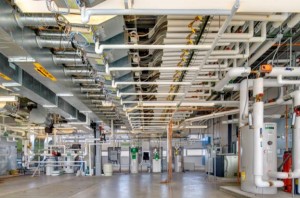Can your building environment affect the way you think and perform?
We know green buildings conserve natural resources, minimize environmental impacts and improve the indoor environment, but do you know it can also positively affect your cognitive performance? A recent study reveals it all.
The study was conducted at the Total Indoor Environmental Quality Laboratory at the Syracuse Center of Excellence in Syracuse, New York.
SINGAPORE — Improved indoor environmental quality doubled participants’ scores on cognitive function tests, according to a new study by researchers at the Harvard University T.H. Chan School of Public Health’s Center for Health and the Global Environment, SUNY Upstate Medical University and Syracuse University . The study was released in Singapore on December 4, 2015 . Primary support for the study came from United Technologies (NYSE: UTX) and its UTC Climate, Controls & Security business.
“The Impact of Green Buildings on Cognitive Function” study found that employees’ cognitive performance scores averaged 101 per cent higher in green building environments with enhanced ventilation compared to a conventional building environment.
“When it comes to the decision-making ability of green building occupants, intelligence is in the air,” said John Mandyck , United Technologies Chief Sustainability Officer. “We know green buildings conserve natural resources, minimize environmental impacts and improve the indoor environment, but these results show they can also become important human resource tools for all indoor environments where cognitive abilities are critical to productivity, learning and safety.
“The payback for improved indoor environmental quality far outweighs the investment, considering that more than 90 per cent of the costs associated with a building are related to the people who work within it once construction is completed,” he added.
Study participants’ cognitive function was measured daily within the environmentally controlled space at the Total Indoor Environmental Quality Laboratory at the Syracuse Center of Excellence.
“The results of this study signal that we should place equal importance on the improved indoor air quality provided by green buildings, not only for health reasons, but also to improve cognitive function and productivity,” said Tan Boon Kuan , group general manager, Carrier Singapore.
The double-blind study evaluated the cognitive performance of 24 participants who experienced conditions in a laboratory setting that simulate those found in conventional and green buildings, as well as green buildings with enhanced ventilation. Researchers measured cognitive function for nine functional domains, including basic, applied and focused activity levels; task orientation; crisis response; information seeking; information usage; breadth of approach; and strategy.
The largest improvements in cognitive function test scores occurred in the areas of crisis response, information usage and strategy.
- Crisis response scores were 97 percent higher for the green environment and 131 percent higher for the green environment with enhanced ventilation and lower carbon dioxide levels compared to the conventional environment.
- Information usage scores for green and enhanced green environments were 172 and 299 percent higher than in the conventional environment, respectively.
- For strategy, green and enhanced green scores were 183 and 288 percent higher than the conventional environment.
Scientists controlled indoor environmental quality to simulate conventional and green building conditions.
The Center for Health and the Global Environment at the Harvard Chan School and SUNY Upstate Medical are launching a second phase of research, which will move from the lab into real buildings across the United States . This research will also be supported by a gift from United Technologies.
The full report is available at www.CHGEHarvard.org/COGfxStudy and www.theCOGfxStudy.com . Follow the discussion on Twitter using the hashtags #COGfxStudy and #IntelligenceInTheAir.





